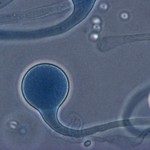Link to Pubmed [PMID] – 33163149
Link to DOI – 10.1016/j.csbj.2020.10.005
Comput Struct Biotechnol J 2020 ; 18(): 2890-2896
Pneumocystis jirovecii is an atypical fungus responsible for severe respiratory infections, often reported as local outbreaks in immunocompromised patients. Epidemiology of this infection, and transmission risk emphasises the need for developing genotyping techniques. Currently, two methods have emerged: Multilocus Sequence typing (MLST) and microsatellite length polymorphism (MLP). Here we compare an MLST strategy, including 2 nuclear loci and 2 mitochondrial loci, with an MLP strategy including 6 nuclear markers using 37 clinical PCR-positive respiratory samples from two French hospitals. Pneumocystis jirovecii MLST and MLP provided 30 and 35 different genotypes respectively. A higher number of mixed infections was detected using MLP (48.6% vs. 13.5% respectively; p = 0.002). Only one MLP marker (STR279) was statistically associated with the geographical origin of samples. Haplotype network inferred using the available genotypes yielded expanded network for MLP, characterized by more mutational steps as compared to MLST, suggesting that the MLP approach is more resolutive to separate genotypes. The correlation between genetic distances calculated based on MLST and MLP was modest with a R 2 value = 0.32 (p < 0.001). Finally, both genotyping methods fulfilled important criteria: (i) a discriminatory power from 97.5% to 99.5% and (ii) being quick and convenient genotyping tools. While MLP appeared highly resolutive regarding genotypes mixture within samples, using one genotyping method rather than the other may also depend on the context (i.e., MLST for investigation of suspected clonal outbreaks versus MLP for population structure study) as well as local facilities.



